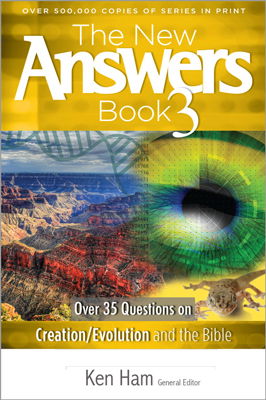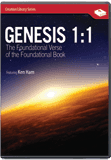
Chapter 4
What Are “Kinds” in Genesis?
Often, people are confused into thinking that a “species” is a “kind.” But this isn’t necessarily so.
“Zonkeys, Ligers, and Wholphins, Oh My!” Although not exactly the same mantra that the travelers in the classic Wizard of Oz repeat, these names represent real life animals just the same. In fact, two of these strange-sounding animals, a zonkey and a zorse, can now be seen at the new Creation Museum petting zoo. But what exactly are these animals and how did they come to be? Are they new species? Can the Bible explain such a thing?
What Is a “Kind”?

Figure 1. Zonkey and zorse at the Creation Museum
The first thing that needs to be addressed is: “What is a kind?” Often, people are confused into thinking that a “species” is a “kind.” But this isn’t necessarily so. A species is a man-made term used in the modern classification system. And frankly, the word species is difficult to define, whether one is a creationist or not! There is more on this word and its definition and relationship to “kinds” later in this chapter. The Bible uses the term “kind.” The Bible’s first use of this word (Hebrew: min) is found in Genesis 1 when God creates plants and animals “according to their kinds.” It is used again in Genesis 6 and 8 when God instructs Noah to take two of every kind of land-dwelling, air-breathing animal onto the ark and also in God’s command for the animals to reproduce after the Flood. A plain reading of the text infers that plants and animals were created to reproduce within the boundaries of their kind. Evidence to support this concept is clearly seen (or rather not seen) in our world today, as there are no reports of dats (dog + cat) or hows (horse + cow)! So a good rule of thumb is that if two things can breed together, then they are of the same created kind. It is a bit more complicated than this, but for the time being, this is a quick measure of a “kind.”
As an example, dogs can easily breed with one another, whether wolves, dingoes, coyotes, or domestic dogs. When dogs breed together, you get dogs; so there is a dog kind. It works the same with chickens. There are several breeds of chickens, but chickens breed with each other and you still get chickens. So there is a chicken kind. The concept is fairly easy to understand.
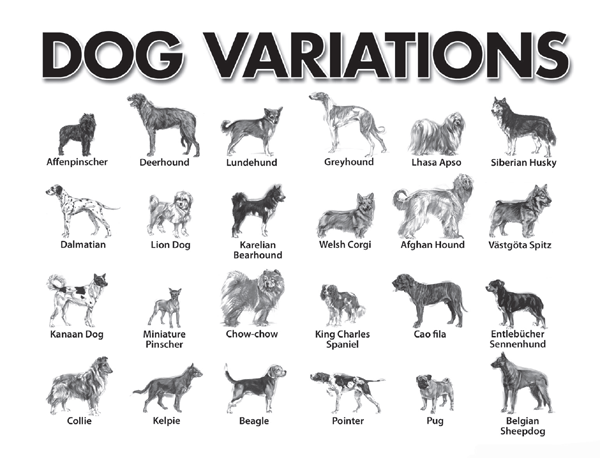
Figure 2. Domestic dogs all belong to the same dog kind.
But in today’s culture, where evolution and millions of years are taught as fact, many people have been led to believe that animals and plants (that are classed as a specific “species”) have been like this for tens of thousands of years and perhaps millions of years. So when they see things like lions or zebras, they think they have been like this for an extremely long time.
From a biblical perspective, though, land animals like wolves, zebras, sheep, lions, and so on have at least two ancestors that lived on Noah’s ark, only about 4,300 years ago. These animals have undergone many changes since that time. But dogs are still part of the dog kind, cats are still part of the cat kind, and so on. God placed variety within the original kinds, and other variation has occurred since the Fall due to genetic alterations.
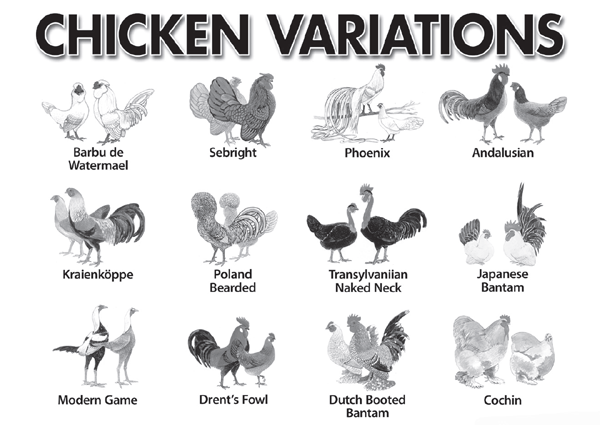
Figure 3. The amazing variety of chicken breeds all belong to the same kind.
Variety within a “Kind”
Creation scientists use the word baramin to refer to created kinds (Hebrew: bara = created, min = kind). Because none of the original ancestors survive today, creationists have been trying to figure out what descendants belong to each baramin in their varied forms. Baramin is commonly believed to be at the level of family and possibly order for some plants/animals (according to the common classification scheme of kingdom, phylum, class, order, family, genus, species). On rare occasions, a kind may be equivalent to the genus or species levels.
Baraminology is a field of study that attempts to classify fossil and living organisms into baramins.
Baraminology is a field of study that attempts to classify fossil and living organisms into baramins. This is done based on many criteria, such as physical characteristics and DNA sequences. For living organisms, hybridization is a key criterion. If two animals can produce a hybrid, then they are considered to be of the same kind.1 However, the inability to produce offspring does not necessarily rule out that the animals are of the same kind, since this may be the result of mutations (since the Fall).
Zonkeys (from a male zebra bred with a female donkey), zorses (male zebra and female horse), and hebras (male horse and female zebra) are all examples of hybrid animals. Hybrid animals are the result of the mating of two animals of the same “kind.” Perhaps one of the most popular hybrids of the past has been the mule, the mating of a horse and donkey. So seeing something like a zorse or zonkey shouldn’t really surprise anyone, since donkeys, zebras, and horses all belong to the horse kind.

Figure 4. Horses of all shapes and sizes are of the same kind.
The concept of kind is important for understanding how Noah fit all the animals on the ark. If kind is at the level of family/order, there would have been plenty of room on the ark to take two of every kind and seven of some. For example, even though many different dinosaurs have been identified, creation scientists think there are only about 50 “kinds” of dinosaurs. Even though breeding studies are impossible with dinosaurs, by studying fossils one can ascertain that there was likely one Ceratopsian kind with variation in that kind and so on.
After the Flood, the animals were told to “be fruitful and multiply on the
earth
” (Genesis 8:17). As they did this, natural selection,
mutation, and other mechanisms allowed speciation within the kinds to occur.
Speciation was necessary for the animals to survive in a very different post-Flood
world. This is especially well illustrated in the dog kind in which current
members (e.g., coyotes, dingoes, and domestic dogs) are confirmed to be descended
from an ancestral type of wolf.2
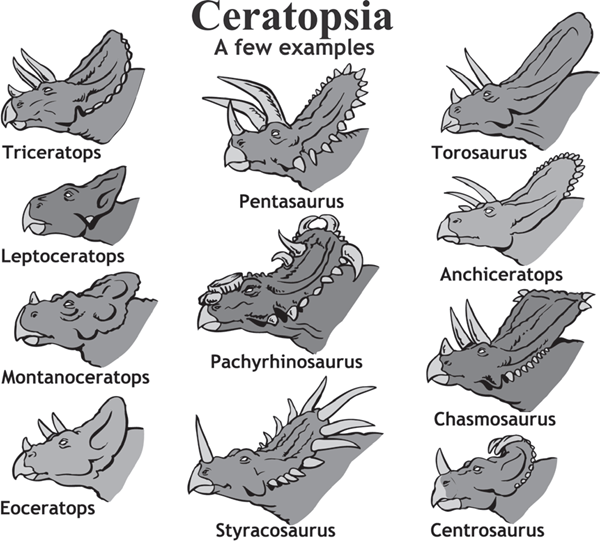
Figure 5. Using fossil evidence, we can identify kinds within the dinosaurs.
Hybrid animals are usually the result of parent animals that have similar chromosome numbers. Many times the hybrids are infertile due to an uneven chromosome number that affects the production of eggs and sperm. However, this is not always the case, as even some mules (horse + donkey) have been known to reproduce. Consider some of the following amazing animal hybrids.
Zonkeys, Zorses, and Mules
These hybrids are the result of mating within the family Equidae. As we’ve said before, zonkeys are the result of mating a male zebra and a female donkey; zorses are the result of mating a male zebra and a female horse; and mules are the result of mating a male donkey and a female horse. But reverse matings (such as hinnies produced from a male horse and female donkey) are rare, although still possible. All are considered “infertile” due to uneven chromosome numbers, but fertility has been observed in some cases. Zonkeys and zorses have a mixture of their parents’ traits, including the beautiful striping patterns of the zebra parents.
Ligers, Tigons, and Other Cats
These hybrids are the result of mating within the family Felidae. Ligers are the result of mating a male lion and a female tiger. Ligers are the largest cats in the world, weighing in at over 1,000 pounds (450 kg). Tigons are the result of mating a female lion and a male tiger. These matings only occur in captivity, since lions live in Africa, tigers live in Asia, and the two are enemies in the wild. Female hybrids are typically fertile while male hybrids are not.
Other hybrids in this family include bobcats that mate with domestic cats and bobcats with lynx (Blynx and Lynxcat). There have been mixes of the cougar and the ocelot, as well as many others. This shows that large, midsize, and small cats can ultimately interbreed, and therefore suggests that there is only one cat kind.
Wolphin
Turning to the ocean, this hybrid is the result of mating within the family Delphinidae. The wholphin is the result of mating a false killer whale (genus Pseudorca) and bottlenose dolphin (genus Tursiops). Such a mating occurred in captivity at Hawaii’s Sea Life Park in 1985.3 The wholphin is fertile. This hybrid shows the difficulty of determining the species designation, since a major criterion is the ability to interbreed and produce fertile offspring. Even though the whale and dolphin are considered separate genera, they may, in fact, belong to the same species. This shows how difficult it is to define the term species. Of course, from a biblical perspective it is easy to say they are both the same kind!
“Fixity of Species” and Changing Definitions
So what is the relationship between the kinds and species anyway? If one were to ask around to see what kind of definitions people have of the word species [or genus], most would respond by saying they have something to do with classification. In today’s society, the words genus and species are synonymous with the Linnaean taxonomy system.
In the early 1700s, if someone said something about a “species” or “genus,” it would have had nothing to do with classification systems. So why is this important today and what can we learn from it? The word species, and its changing definition, were partly responsible for the compromise of the Church in late 1800s. In fact, the Church is still struggling over this change. Let’s do a brief history review.
Species: Origin and Meaning
The English word species comes directly from Latin. For example, the Latin Vulgate (early Latin Bible translation), by Jerome around A.D. 400, says of Genesis 1:21:
creavitque Deus cete grandia et omnem animam viventem atque motabilem quam produxerant aquae in species suas et omne volatile secundum genus suum et vidit Deus quod esset bonum [emphasis added].
Species is also found in the Latin version in Genesis 1:24, 25 as well. The Latin basically meant the biblical “kind.” In fact, this word carried over into English (and other languages that have some Latin influence). It means a “kind, form, or sort.” Another word that was commonly used for a kind in the Latin Vulgate was genus. This is evident in Genesis 1:11, 12, and 21. In both cases, these two words (species and genus) were used for the Hebrew word min or kind.
It made sense that Carl Linnaeus, a Swedish Christian, began using Latin terms for his new classification system. It was logical to use these common terms, which were a part of the commercial language throughout Europe (much in the way that English, for example, is seen as a universal language in the world today for communication and so on). Linnaeus even wrote his large treatise, Systema Natvrae, and other findings, in Latin in the mid to late 1700s.
Early commentators recognized that species originally meant the biblical kinds, as even John Calvin, prominent reformer in the 1500s, stated in his notes on Genesis 1:24:
I say, moreover, it is sufficient for the purpose of signifying the same thing, (1) that Moses declares animals were created “according to their species”: for this distribution carried with it something stable. It may even hence be inferred that the offspring of animals was included. For to what purpose do distinct species exist, unless that individuals, by their several kinds, may be multiplied?
Of course, Calvin originally wrote in Latin, but this early English translation by Thomas Tymme in 1578 still shows the point that the word species was used to mean the biblical kind. Calvin is even pointing out stability or fixity (i.e., biblical kinds). Dr. John Gill, about the same time as Linnaeus, equates species and kinds in his note under Genesis 1:22 by saying:
With a power to procreate their kind, and continue their species, as it is interpreted in the next clause; saying, be fruitful, and multiply, and fill the waters in the seas.
Others, such as Basil, prior to the Latin Vulgate, discussed species as the biblical kind in the fourth century in his Homilies on Genesis 1. Matthew Henry, in the late 1600s and early 1700s, used species as kinds in his notes on Genesis 2:3, saying there would be no new “species” created after creation week had completed. The list could continue. The point is that species originally meant the biblical kind.
Species: A Change

Figure 6. Original definition of species: all dogs were one species.
After Linnaeus, both of these words (species and genus) were commonly used in modern biological classification systems with slightly different definitions. In the mid-to-late 1700s, species began taking on a new, more specific definition in scientific circles as a biological term (that definition is still being debated even today). But, by and large, the definition had changed so that, instead of there being a dog species (or dog kind), there were many dog species.
In the common and Church sense, the word species was still viewed as the biblical “kind.” But as the scientific term gained popularity, this led to a problem. When theologians and members of the Church said “fixity of species” (meaning fixity of the biblical kinds) people readily saw that there were variations among the species (by the new definition). They thought, But species do change! Of course, no one ever showed something like a dog changing into something like a cat. Dogs were still dogs, cats were still cats, and so on.
However, a bait-and-switch fallacy had taken place. Christians were teaching fixity of species (kinds), but the definition of species changed out from under them. So Christians looked ignorant when people began observing that species—by the new definition—do change. Of course, in reality, this was merely variation within the created kinds. For example, dogs could be observed changing into something different—still dogs, but not looking like other “species” (by the new definition) of dogs. So it appeared that the created kinds were becoming new species (new definition), even though the animals did not change into a different kind of animal. It appeared that the Church was wrong.
Perhaps the most influential critique of fixity of species came from Charles Darwin, whose book On the Origin of Species tackled the misunderstood idea of fixity of species (though it never used the term “fixity”). Mr. Darwin studied many creatures during his travels and realized there was variation and not fixity of species (by the new definition).
The Implications

Figure 7. New definition of species: several wolf species, several coyote species, etc.
The results of this were devastating to the Church. And people began doubting the Word of God as a result, walking away from Christianity, and embracing an evolutionary philosophy. George Bentham, writing May 30, 1882, to Francis Darwin regarding his father Charles’s ideas, said:
I have been throughout one of his most sincere admirers, and fully adopted his theories and conclusions, notwithstanding the severe pain and disappointment they at first occasioned me. On the day that his celebrated paper was read at the Linnean Society, July 1st, 1858, a long paper of mine had been set down for reading, in which, in commenting on the British Flora, I had collected a number of observations and facts illustrating what I then believed to be a fixity in species, however difficult it might be to assign their limits, and showing a tendency of abnormal forms produced by cultivation or otherwise, to withdraw within those original limits when left to themselves. Most fortunately my paper had to give way to Mr. Darwin’s and when once that was read, I felt bound to defer mine for reconsideration; I began to entertain doubts on the subject, and on the appearance of the ‘Origin of Species,’ I was forced, however reluctantly, to give up my long-cherished convictions, the results of much labour and study, and I cancelled all that part of my paper which urged original fixity, and published only portions of the remainder in another form, chiefly in the ‘Natural History Review.’4
Even today, an objection commonly leveled at the Bible is that it claims that species are fixed. A good response would be: “To which definition of species are you referring?” By the old definition (as a kind), creationists would agree, but would probably better state it in modern English as fixity of the created kinds so as not to confuse the issue. The idea of one kind changing into another can be argued against based on the fact that no such change has ever been observed.
After Darwin’s book, many churches gave up fixity of species (by either definition) and began taking compromised positions such as theistic evolution (basically giving up Genesis for molecules-to-man evolution and then picking up with Abraham). Realizing that the Church had been duped by a bait-and-switch fallacy provides a valuable learning tool. When people fail to understand history, they often repeat it.
A Great Place for Creation Research
All of these animals’ ancestors that we have discussed above—horses, donkey, zebras, tigers, lions, whales, and dolphins—were created with genetic diversity within their various kinds (or by the older definition of species). Through time, the processes of natural selection, mutation, and other mechanisms have altered that original information (decreased or degenerated) to give us even more variation within a kind.
Great variety can be observed in the offspring of animals of the same kind, just as the same cake recipe can be used to make many different cakes with various flavors and colors. Hybrids have a portion of the same genetic information as their parents but combined in a unique way to give a very unique-looking animal. What an amazing diversity of life God has created for us to enjoy!
The study of created kinds is an exciting area of research, and our hope is to help encourage others to get involved. Whether studying the duck-goose kind, elephant-mammoth kind, camel-llama kind, apple-pear kind, or others, the field of baraminology is a great place for biologists, botanists, geneticists, and paleontologists (for extinct kinds) to get immersed in creation research.
The New Answers Book 3
Do you have answers to the big questions about the Christian faith, evolution, creation, and the biblical worldview? Now you get the important information you need regarding the existence of God, global warming and climate change, cloning and stem cells, human and chimp DNA, the importance of Mount St. Helens, and more.
Read Online Buy BookFootnotes
- Some might argue that if the hybrid offspring are infertile, then this indicates that the parent animals are of separate created kinds. However, fertility of the offspring has no bearing on the kind designation. Hybridization is the key.
- Savolainen et al., “Genetic Evidence for an East Asian origin of Domestic Dogs,” Science 298 (2002): 1610–1613.
- Stephen Adams, “Dolphin and Whale Mate to Create a ‘Wholphin,’ ” Telegraph.co.uk website news, April 2, 2008, Telegraph Media Group Limited, www.telegraph.co.uk/news/uknews/1582973/Dolphin-and-whale-mate-to-create-a-wolphin.html.
- Francis Darwin, ed., The Life and Letters of Charles Darwin Including an Autobiographical Chapter, Volume 2, as produced by Classic Literature Library, Free Public Book Domain, originally published in 1897, www.charles-darwin.classic-literature.co.uk/the-life-and-letters-of-charles-darwin-volume-ii/ebook-page-41.asp
Recommended Resources

Answers in Genesis is an apologetics ministry, dedicated to helping Christians defend their faith and proclaim the good news of Jesus Christ.
- Customer Service 800.778.3390
- © 2024 Answers in Genesis

